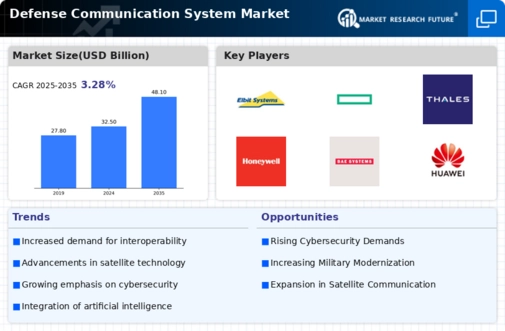North America : Defense Innovation Leader
North America remains the largest market for Defense Communication Systems, holding approximately 45% of the global share. The region's growth is driven by increasing defense budgets, technological advancements, and a focus on cybersecurity. Regulatory support from government initiatives, such as the National Defense Authorization Act, further catalyzes market expansion. The demand for secure communication systems is rising, particularly in response to geopolitical tensions and evolving threats.
The United States is the leading country in this sector, with major players like Lockheed Martin, Northrop Grumman, and Raytheon Technologies dominating the landscape. These companies are at the forefront of innovation, developing advanced communication technologies for military applications. The competitive environment is characterized by significant investments in R&D and strategic partnerships, ensuring that North America maintains its leadership in defense communication systems.
Europe : Growing Defense Collaboration
Europe is witnessing a significant increase in the Defense Communication System market, accounting for approximately 30% of the global share. The growth is fueled by collaborative defense initiatives among EU nations, rising security concerns, and the need for interoperable communication systems. Regulatory frameworks, such as the European Defence Fund, are enhancing investment in defense capabilities, driving demand for advanced communication solutions across member states.
Key players in Europe include Thales Group, BAE Systems, and Leonardo, which are actively involved in developing cutting-edge communication technologies. Countries like France, Germany, and the UK are leading the charge, focusing on enhancing their defense communication infrastructure. The competitive landscape is marked by partnerships and joint ventures aimed at fostering innovation and meeting the evolving needs of defense forces across Europe.
Asia-Pacific : Emerging Defense Market
The Asia-Pacific region is emerging as a significant player in the Defense Communication System market, holding about 20% of the global share. The growth is driven by increasing military expenditures, modernization efforts, and regional security challenges. Countries are investing heavily in advanced communication technologies to enhance their defense capabilities, supported by government initiatives aimed at strengthening national security and defense infrastructure.
Leading countries in this region include China, India, and Japan, with a competitive landscape featuring both established players and new entrants. Companies like L3 Technologies and Harris Corporation are expanding their presence in the region, focusing on tailored solutions for local defense needs. The market is characterized by rapid technological advancements and a growing emphasis on cybersecurity, ensuring that Asia-Pacific remains a dynamic and competitive environment for defense communication systems.
Middle East and Africa : Strategic Defense Investments
The Middle East and Africa region is witnessing a gradual increase in the Defense Communication System market, accounting for approximately 5% of the global share. The growth is primarily driven by geopolitical tensions, military modernization programs, and the need for secure communication channels. Governments are increasingly recognizing the importance of advanced communication systems in enhancing national security, leading to regulatory support for defense investments and procurement initiatives.
Countries like Saudi Arabia, the UAE, and South Africa are at the forefront of this market, with a focus on acquiring advanced communication technologies. The competitive landscape includes both local and international players, with companies seeking to establish partnerships to meet the unique defense requirements of the region. As defense budgets increase, the demand for innovative communication solutions is expected to rise, positioning the Middle East and Africa as a growing market for defense communication systems.

















Leave a Comment